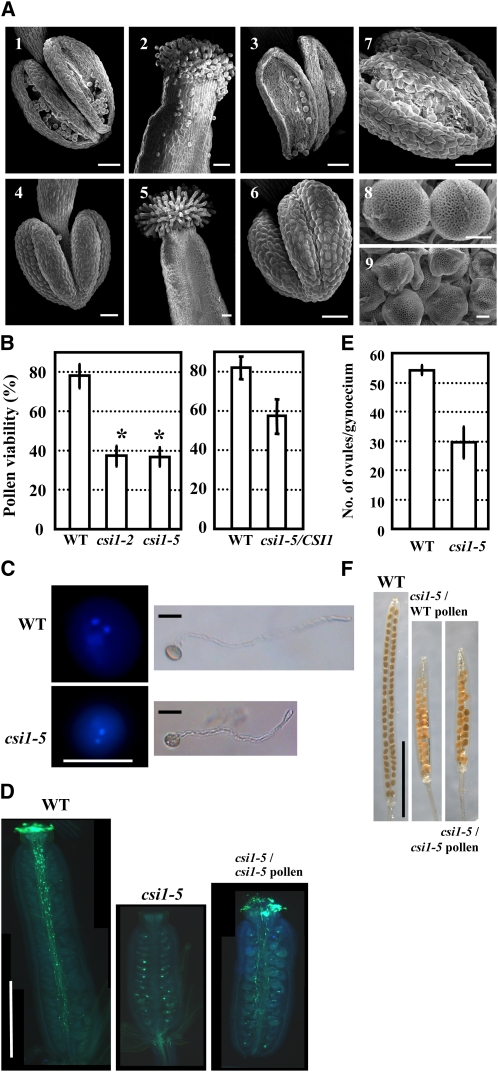Figure 2.
Morphological and Developmental Comparison between Wild-Type and csi1-2 Anthers and Pollen.
(A) Scanning electron microscope analysis of wild-type and csi1-2 anthers, stigmas, and pollen grains. (1), (2), (3), and (8) show wild-type floral organs. Anther at stage 13 (1); stigma (2), anther (3), and pollen grains (8) at late anther stage 13. (4) to (7) and (9) show csi1-2 floral organs at the same stages as in the wild type.
(B) Pollen viability of the wild type (WT), csi1-2, and csi1-5 homozygous mutant (left), and heterozygous csi1-5/CSI1 plant (right), as determined by FDA staining. Heteroscedastic t tests were conducted to compare pollen viability of homozygous csi1-2, csi1-5, or heterozygous csi1-5/CSI1 with that of the wild type (*, P < 0.01). Error bars represent se (n > 1300).
(C) Staining of pollen grains with DAPI indicates that both wild-type and csi1-5 pollen grains harbored one vegetative nucleus and two reproductive nuclei (left). In vitro culture of pollen grains showed that both wild-type and csi1-5 pollen grains could germinate and elongate normally after 4 h of culture (right).
(D) In vivo pollen tube growth assay using aniline blue staining showed the pollen tubes in a wild-type pistil at stage 14, whereas no pollen or pollen tubes could be observed in the csi1-5 homozygous mutant pistil. Elongated pollen tubes could be observed 6 h after manually opening the csi1-5 anther and pollinating the pollen to the csi1-5 pistil.
(E) Average number of ovules in one wild-type or homozygous csi1-5 pistil. A heteroscedastic t test was conducted to compare the ovule number per pistil of csi1 with the wild type. Error bars represent se (n = 12).
(F) Fruits developed from a csi1-5 pistil manually pollinated with wild-type (middle) or released csi1-5 (right) pollen compared with those developed from a wild-type pistil (left).
Bars in (A) (1) to (7) = 50 μm and (8) and (9) = 5 μm; bars in (C) = 10 μm; bars in (D) = 0.25 cm; bars in (F) = 0.5 cm.

